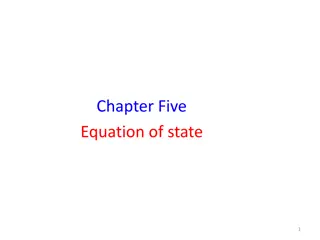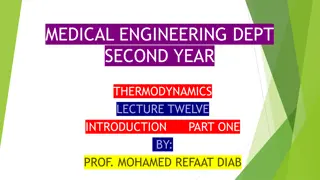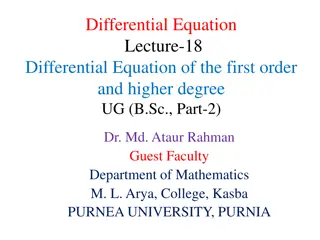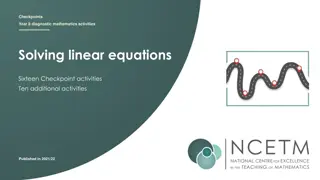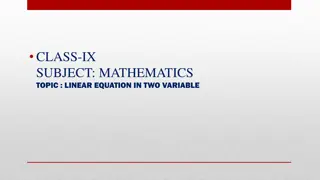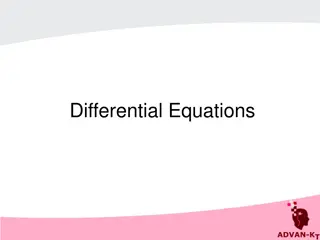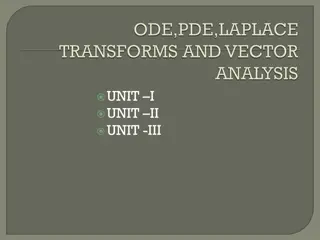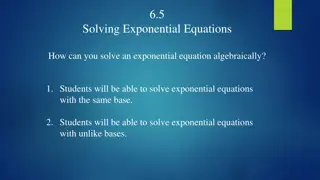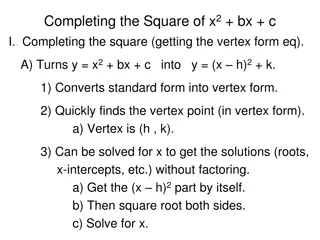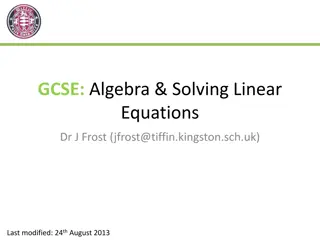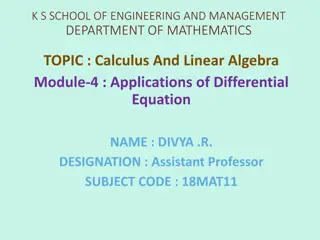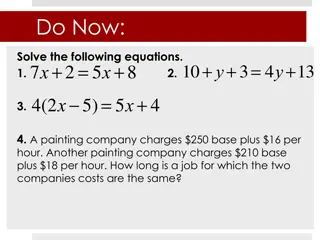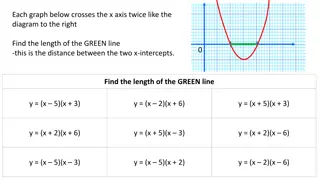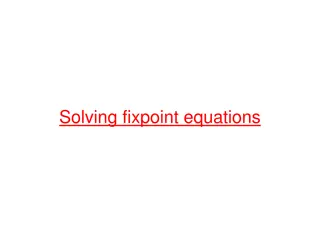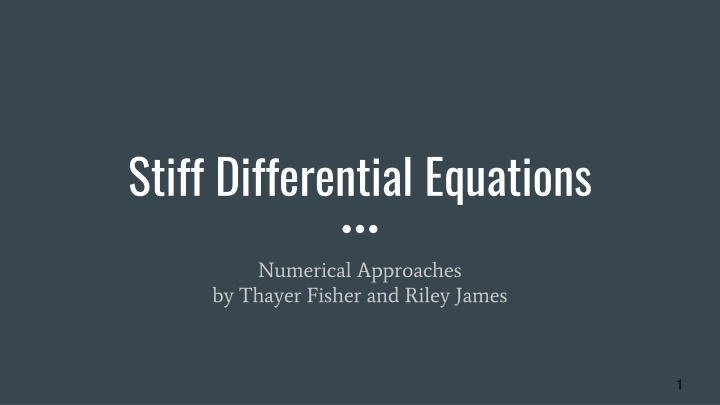
Understanding Stiff Differential Equations and Numerical Approaches
"Explore the concept of stiff differential equations, their characteristics, and numerical methods to solve them. Learn about stability, examples, and practical applications in this comprehensive guide."
Download Presentation

Please find below an Image/Link to download the presentation.
The content on the website is provided AS IS for your information and personal use only. It may not be sold, licensed, or shared on other websites without obtaining consent from the author. If you encounter any issues during the download, it is possible that the publisher has removed the file from their server.
You are allowed to download the files provided on this website for personal or commercial use, subject to the condition that they are used lawfully. All files are the property of their respective owners.
The content on the website is provided AS IS for your information and personal use only. It may not be sold, licensed, or shared on other websites without obtaining consent from the author.
E N D
Presentation Transcript
Stiff Differential Equations Numerical Approaches by Thayer Fisher and Riley James 1
Outline Intro A simple example Proper definition Real world example Solutions Runge-Kutta, Dormond-Prince/ode23s Conclusion 2
What is a Stiff Differential Equation? A differential equation Numerically unstable, requiring a small step size to solve using traditional methods Includes a term that leads to rapid variation in the slope Often this is variation around a stable solution as t gets large The problem caused by stiffness is the time it takes to solve Extremely simple ODE s can fail under traditional numerical methods 3
A Simple Example Consider the simple ODE: ?? ??= 10? ?(0) = 1. We know that the solution to this ODE is: ?(?) = ? 10? However, the numerical solution using Euler s Method runs into some problems... 4
A Simple Example 300 250 200 150 y(t) 100 50 0 0 0.5 1 1.5 2 2.5 -50 -100 0.125 0.5 0.25 t 5
A-Stability How do we quantify the stability of the numerical solution? ??+1= ??+ ?(??) ??+1= ?? 10 ?? ??+1= 1 10 ?? By Induction: ??= ?0 1 10 ? 2 10 Which is convergent for 1 10 < 1 or < 6
More A-Stability Generalizing this concept for the test equation ? = ?,? 0 = 1 ??+1= 1 ??=? ? ??, where ? = The numerical method is called A-Stable if ? ? < 1, ? ?,Re z < 0 Note that this region corresponds to the left half-plane, since z can be complex A-Stability tells us that the numerical method is always stable around the origin Further, if it is also the case that ? ? 0 as ? , the numerical method is called L-Stable. L-Stable methods are good for solving stiff equations. 7
A More In-Depth Example Stiffness can be seen in several differential equations that model the real world: Propagating Flame Model: ?? ??= ?2 ?3 ?(0) = ?, where ? is small (.0001) 2 ? 0 < ? < 8
Runge-Kutta Method 4th order Runge-Kutta, modified version is ode45: ?1= ? ?? ?2= ? ??+ 0.5 ?1 ?3= ? ??+ 0.5 ?2 ?4= ?(??+ ?3) ??+1= ??+ 6(?1+ 2?2+ 2?3+ ?4) ynis the value of y at the nthtimestep and h is the step size Variation on Euler's Method, using the weighted averages of 4 intervals between tnand tn+1 9
Applied to our IVP h = 1 ?1=.00012 .00013= 9.999 10 9 ?2= ? ?0+ 0.5 ?1 = .0001 + .5 9.999 10 9 2 .0001 + .5 9.999 10 9 3= 9.999 10 9 ?3= ? ?0+ 0.5 ?2 = 9.999 10 9 ?4= ? ?0+ ?3 = .0001 + 9.999 10 9 2 .0001 + 9.999 10 9 3= 1.000 10 8 ?1= .0001 +1 ?1+ 2?2+ 2?3+ ?4= 1.0001 10 4 6 10
Plot of flame propagation system using ode45 zoomed around (1,1) Plot of the flame propagation system using ode45 with = .0001 11
Dormand-Prince Method Matlab ODE Suite has several modifications on the previous methods that work on surpassing the stiffness of a system ode23s Modified implicit Rosenbrock method of orders 3 and 2 Used to recognize drastic changes in the system at both the beginning and the end of each step New Jacobian formed at each step Components can change in each step, warranting a new Jacobian Relatively quick to compute the Jacobian, which is what we care about in the first place 12
Matlabs ode23s hawks When going from tn,yn to ??+1= ??+ : ??= ?(??,??), ?1 = ? 1(?0+ ??), ?1= ?(??+ 0.5 ,??+ 0.5 ?1), ?2= ? 1(?1 ?1) + ?1, ??+1= ??+ ?2, ?2= ?(??+1,??+1), ?3= ? 1[?2 ?32(?2 ?1) 2(?1 ?0+ ??], ????? 6(?1 2?2+ ?3), 2+ 2,?32= 6 + 2,? ?? 1 ????,?? ,??? ? ?? where ? = ? ??,? = ??(??,??). 13
Its Just an IVP ?? ??= ?2 ?3,?0= 0,?0= ? = 0.0001, 0 < ? < 2 ?, = 1 ? = 2? 3?2,? = 1 2? 3?2 = 1 2 .0001 3 .00012 2 + 2 = .99994 2 + 2 ?0= ? 0,.0001 = .00012 .00013= 9.99 10 9, ?1= .99994 19.99 10 9= 9.99 10 9, ?1= ? 0.5,.000100004 = 9.99 10 9, ?2= .99994 19.99 10 9 9.99 10 9+ 9.99 10 9= 9.99 10 9, ?1= .0001 + 9.99 10 9= .00010001 ?2= ? 1,.00010001 = 1.0001 10 8, ?3= .99994 1[1.0001 10 8 6 + 2 9.99 10 9 9.99 10 9 2 9.99 10 9 9.99 10 9 = 9.9986 10 9 ????? 1 69.99 10 9 2 9.99 10 9+ 9.9986 10 9= .0014 10 9 14
Flame propagation system plotted using ode23s, zoomed around (1,1) Flame propagation system plotted using ode23s 15
Finding an Exact Solution The exact solution for the system of a propagating flame can be expressed: 1 ? ? = ? ? ?? ?+1 where a = 1/ -1. The function W(z), the Lambert W function, is the solution to ? ? ?? ? = ? The graph of the exact solution is shown here: 16
Conclusion From this we can conclude: Stiff equations can be solved without being computationally expensive Implicit methods are superior to explicit methods Adjust for drastic changes around equilibrium Explicit methods are more expensive, and require smaller step sizes, but have a higher degree of accuracy than implicit methods for non-stiff ODE s 17
References Ashino, Ryuichi, Michihiro Nagase, and Remi Vaillancourt. "Behind and Beyond the MATLAB ODE Suite." Behind and Beyond the MATLAB ODE Suite (n.d.): n. pag. Web. Dahlquist, Germund (1963), "A special stability problem for linear multistep methods", BIT 3 (1): 27 43 Frank, Jason. "Optimal Implicit SSP Runge Kutta Methods." Strong Stability Preserving Runge-Kutta and Multistep Time Discretizations (2011): 91-107. Utrecht University. Utrecht University. Web. Moler, Cleve. "Ordinary Differential Equations, Stiffness 3." Cleves Corner Cleve Moler on Mathematics and Computing Ordinary Differential Equations Stiffness Comments. MATLAB, n.d. Web. 12 Nov. 2015. Shampine, Lawrence F., and Mark W. Reichelt. "The Matlab ODE Suite." THE MATLAB ODE SUITE (n.d.): n. pag. Mathworks. Mathworks. Web. Weisstein, Eric W. "Runge-Kutta Method." From MathWorld--A Wolfram Web Resource. 18


